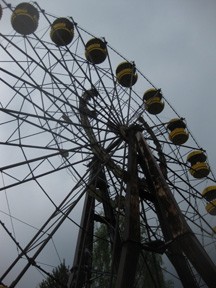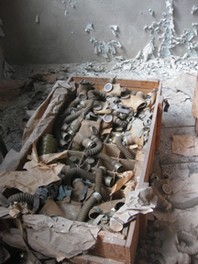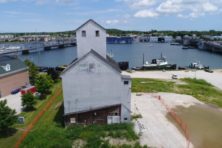Desolate Ways: Strange is the Zone of Estrangement
- Share
- Tweet
- Pin
- Share

An abandoned Ferris wheel looms over the ghost city of Chernobyl.
Chernobyl is the first thing that comes to my mind when I think of Ukraine. As children of the atomic age, we have all grown to fear and respect the atom. And Chernobyl is the first thing one thinks of when we talk about nuclear accidents. Surprisingly enough, it’s become a bit of a tourist destination.
I arrive in Kiev with the sole intent of visiting Chernobyl. I’m only staying in the country for three nights. I’m apprehensive. But I find that the Ukrainians are not at all hostile or insane, and hit it off well right away with the natives. They’re hospitable, friendly. Playful, even. The elderly blond woman from whom I am renting a flat is particularly kind. She feeds me borsch and lends me a telephone. But she doesn’t understand why anyone would want to go to Chernobyl. “We’ve lived with that thing for 25 years,” she shakes her head. “There are much better things to see in this country.”
While this does nothing to deter me, I am slightly bummed that the excursion I’m on will be conducted in English and geared for foreign tourists. Non-foreigners usually get a significantly lower rate, as well. Luckily, most of the tourists are well behaved and pleasant, in particular the friendly Aussie girls sitting next to me on the bus.
While there are no “ugly Americans,” there is a trio of “ugly Dutchmen,” or rather, drunk and obnoxious Dutchmen. While trying to take in the stark beauty that is the Zone of Estrangement (the area bereft of permanent residents around the power plant), my fellow travelers and I are mercilessly assaulted with the aural torment of gaudy jokes delivered in the guttural Dutch language and the equally appalling odor of these stinking Dutchmen. They’ve evidently come to Kiev for what my new Aussie friends would call a “stag weekend.”

School’s out – a deserted classroom in Pripyat.
Once we reach the 30-kilometer perimeter marking the Zone of Estrangement, a soldier enters the bus and checks our passports. The road leading forward is anticlimactic: it’s well paved with the occasional forest fire prevention billboard. If it weren’t for the complete lack of buildings, it could be anywhere in Ukraine.
Then it starts getting weird, albeit quite gradually.
Behind the thick blanket of green spring buds, you can catch a brief glimpse of abandoned houses that flash by like ghosts. Sometimes I feel as though I’m hallucinating, or catching a stray reflection in the window. What appear to be deer trails are actually streets, emerald tunnels penetrating deep into forsaken towns. Across sweeping fields are sprinkled cute little triangular yellow signs with red radiation symbols painted on them, like sunflowers from hell.
In the city of Chernobyl, we meet our reasonably likeable guides. The main one is a mulleted Ukrainian clad in faded camouflage, but there’s also a pasty red head and chain-smoking balding man, who speak a lot less English. Though the radiation level is nearly normal here, there’s only a skeleton crew that lives and works here, a mere 10 kilometers from the plant. It feels like the northern side of the Korean DMZ all over again. The town is quaint and pretty. There is a graveyard of villages that were completely razed following the accident, as well as a few other monuments. Oh, and the clock on the post office displays the radiation level rather than temperature. I’m relieved to be receiving 12 micro-roentgens per hour. That’s almost normal.

Nate Jacobs poses in front of Reactor 4.
“Radiation is silent, invisible, tasteless, and without smell. If you do smell or taste it, you will be dead within hours,” Mulletman informs us. It’s hard to say if that is comforting or disturbing.
“What do you think of this?” the Russian-speaking, balding guide asks me. I reply that it’s interesting. He laughs. “This is nothing. Wait until we get into Pripyat. It’s like a jungle.”
The attitude is shockingly laid back. Though we are carefully carted to each destination and counted upon returning to the bus, the guides usually set us free to wander. Our first stop is a kindergarten about 5 kilometers from the plant, seemingly in the woods. Mattresses and stuffed animals vomit forth their stuffing through holes in their fabric. There is broken glass everywhere. Everything is where it was dropped when the Soviet government evacuated everyone, several days after the accident. A small playground peeks out from a mass of weeds, a radiation sign in the center of it all.
We stop at a fish hatchery, just down stream from the plant. A complex of unfinished reactors and cooling towers loom in the distance. Trees are growing out of the rusting behemoths. Nature cares not about micro-roentgens or Cesium 137.
Pripyat is truly a jungle. This city was built specifically for workers of the plant. Forests erupt where yards once stood. Buildings stand guard over this nuclear graveyard: a sports center, an amusement park, an elementary school. The danger here is not radiation, but puddles of broken glass, rusty nails and every other nuance of abandoned buildings. Birds chirp a symphony to the mating season, echoed and distorted in vodka-soaked Dutch. To mitigate this, I charge ahead of the group at every stop to get away from the Stinking Dutchmen.

On one of my fugues from the group, I scamper to the roof of the elementary school. While the view is nice, what really sticks in my mind is a room filled with child-sized gas masks. Never used.
Perhaps it’s a preternatural degree of introspection, but I’m actually bothered by this place. Had I been born here, I would have been one of the children who attended this school. The decaying amusement park would have been the local version of Thumb Fun that I loved as a child. There are even bumper cars there, frozen in place, like the ones at Thumb Fun. These, however, are highly radioactive, so I have to resist the childish urge to jump behind the wheel for a photo. A stuffed animal, forgotten 25 years ago sits waiting on the Ferris wheel.
After a brief lunch in the cafeteria for the plant’s employees, we stop at reactor number 4, the scene of the accident, to take some pictures. It’s difficult to imagine the atomic horrors that lurk beneath its massive lead sarcophagus. The only warmth I feel is the bright Ukrainian sunlight, totally oblivious to the gamma rays emanating from that unholy womb. In fact, apart from radiation, the Zone is some sort of Garden of Eden, where humans were ejected for their Promethean transgressions. It’s serene and beautiful. If one were so inclined to become a real life Captain Kurtz, this would be an excellent place to do it.
Thankfully, our dear Dutch friends pass out on the way back to Kiev. Everyone else seems to follow suit. I decide to listen to one of my favorite songs, “Desolate Ways,” which is a simple, pensive acoustic instrumental. Passing through this pristine, yet tragic landscape, no other piece of music could ever perfectly match the mood.


